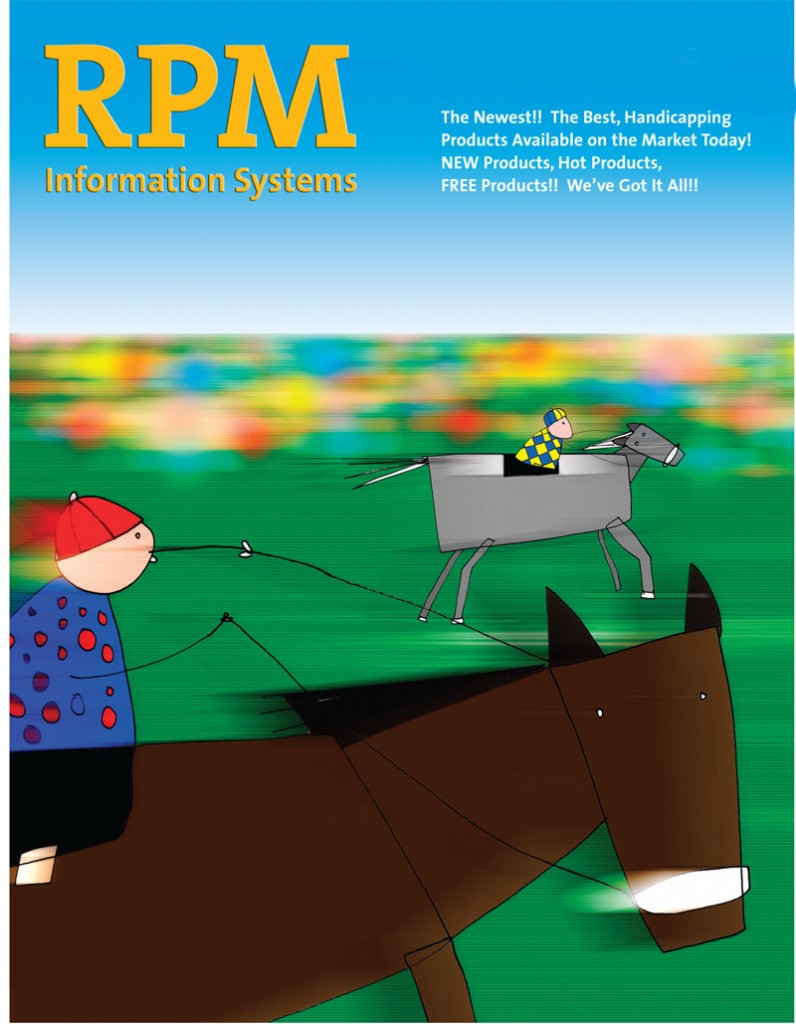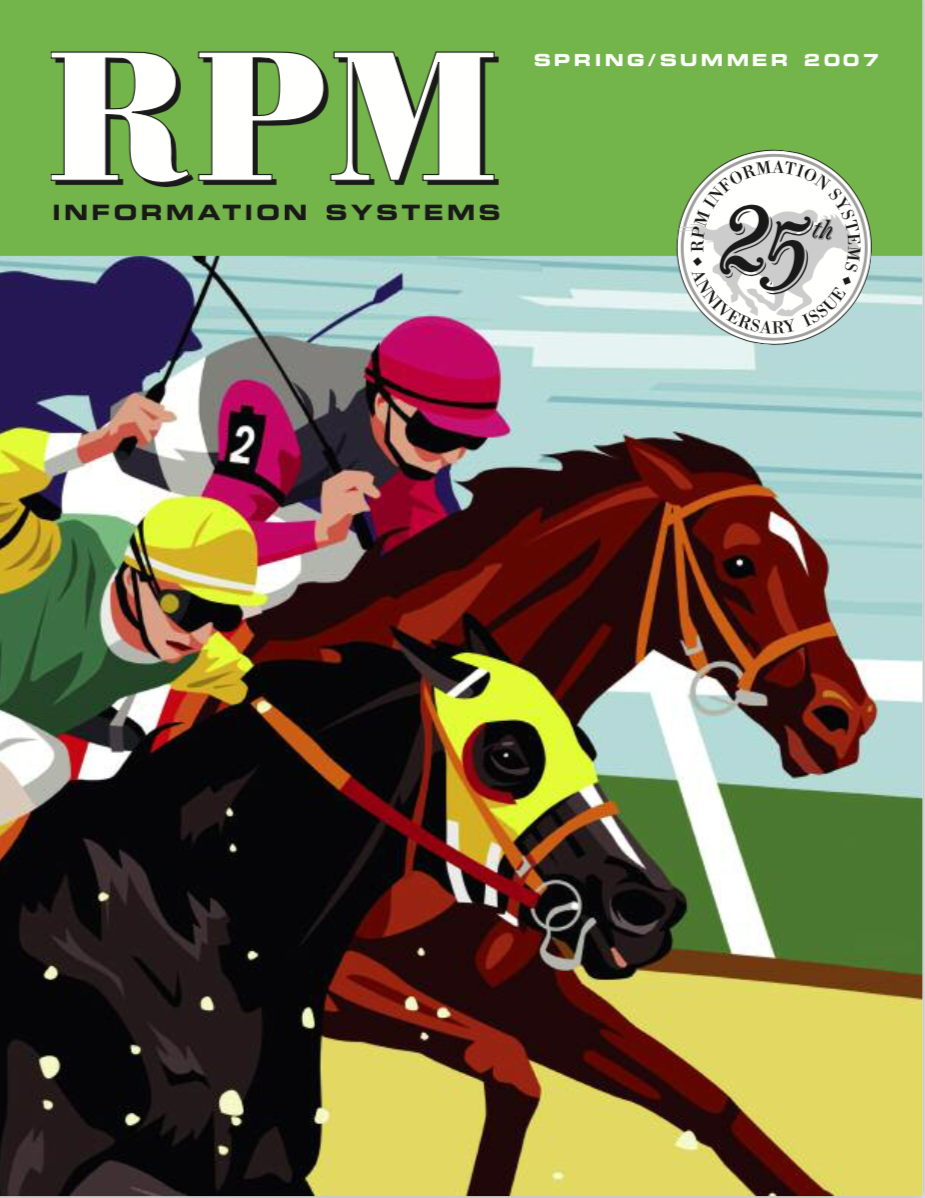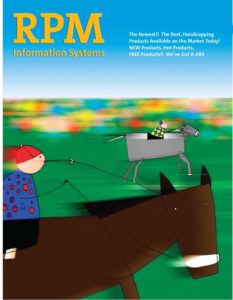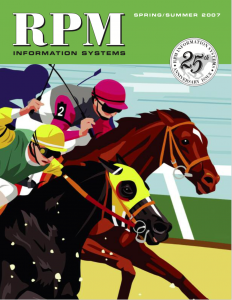Taming The Santa Anita Turf
Forward
I remember sitting in the Caesar’s racebook with master handicapper Ron Ambrose a several years ago discussing the fine points of handicapping. Before his unfortunate illness, Ron was one of the top handicappers in this game, and I respected his opinion immensely. When the subject came around to turf racing, however, Ron simply scowled and said: “Why do you want to bet a turf race? Turf racing is 90% racing luck – whichever horse gets into the least trouble is the one who wins. I don’t have a clue on how to predict the winner of a grass race. Give me dirt sprints where I know who’s going to be in front, and I never have to worry about looking at a turf race.”
Ron made some very good points. Because the turf courses in our country are parked inside of the dirt ovals, they are normaly very narrow and the turns tend to be very tight. This leads to all kinds of confusion when a full field goes blasting out of the gate and into the first turn. Horses who get in trouble by either being blocked or being forced to take up seldom recover in time to get into the running again. And, it certainly can be said that the luckiest horse often wins the race. While I wasn’t big on playing turf races either, I stressed to Ron that I found that the riders often make their own luck. Horses able to clear the early traffic jam and save ground often remain in good position throughout the race which, of course, gives them a much better chance to collect the fat end of the purse. In other words, it was my experience, in Southern California at least, that speed horses had a definite advantage, and if you considered some other important handicapping factors as well, you could more than hold your own betting turf races. Ron agreed, but still had no intention of getting involved in an area which he felt left much more to chance than his cherished sprint races, from which he was turning a fine profit.
Of course, the average racing card is made up of much more than just dirt sprints. And while you may choose not to make straight bets on turf races, if you’re playing Triples, Pick 6’s, Trifectas, etc., you are going to have to take grass races into consideration on occasion. At Santa Anita, in fact, you are going to be dealing with a whole lot of grass racing, so rather than run from these turf affairs, it makes much more sense to learn how to play them. With the Santa Anita meet, which will host the Breeders’ Cup this year, beginning in late September, we thought we’d give you some insights in how to play their newly-widened turf course. That’s what this article, Taming The ‘Anita Turf, is all about. So sit back, read, enjoy and put into practice what you are about to learn. We don’t promise miracles, but we do promise that you will find playing Santa Anita turf course much easier once you have digested the information contained herein.
So the following discussion will help put into perspective exactly what we expect to be dealing with when playing the Santa Anita turf course. We’ve hit on many of the important points in the Santa Anita Analyst, but in this section we’ll look at exactly what has been happening over the Arcadia sod by reviewing past and recent history. So what can we expect in 2013/2014?
Well, we would expect that the turf course will be maintained in the same manner and horses with FRONT and EARLY running styles will continue to do best. But, the usual caveat here, don’t head for the mutuel windows until you are certain this trend is still intact. In other words, if after watching the first dozen or so turf races at the meet, horses with early speed seem to be winning and/or finishing in the Exacta often, then it’s a pretty good bet that you are looking at Santa Anita as usual, i.e., a speed-favoring turf course. If, as we expect, the trend toward speed types does continue, what follows is a profile of the kind of animal that should do well over the Santa Anita turf course this season. We’ll start with some stats gathered from the full-length Track Profile for the Santa Anita turf course from the last three seasons. We will first deal only with route races here.
Winning Pace Style Profile For Turf Races – Santa Anita 2010 – 2013
dist. 1 Mile 1-1/8 Miles 1-1/4 Miles
# of Races 181 157 44
Wire-to-wire 39 (22%) 28 (18%) 6 (14%)
Front 41 (23%) 33 (20%) 8 (18%)
Early 46 (25%) 38 (25%) 13 (29%)
Mid 27 (15%) 27 (17%) 8 (18%)
Late 17 (9%) 17 (11%) 6 (14%)
Rear 11(6%) 14 (9%) 3 (7%)
So what can we gather from the above data? Let’s break it down a little further:
**In One-Mile Turf races horses with early speed were best. 126 of the winners, or 70%, were within 2 lengths of the leader at the 2nd call. That is the total of Wire-to-Wires, Fronts and Earlys (remember that Wire-to-Wire means in front all the way; Front means within 1 length of the leader at the 2nd call and Early means within 2 lengths of the leader at the 2nd call). Fewer than one out of six winners fit the description of Late or Rear. Keep your fingers crossed and hope that this trend continues this year. If horses on or near the lead continue to win at the same clip at this distance, it will make our job so much easier! Basically, we’ll only need to concentrate our efforts on runners who have frontrunning or early speed, because we know the winner will emerge from that contingent the vast majority of the time.
**In 1-1/8 Mile Turf races, the early speed bias moderated just a bit. Still, 99 of the winners, or 63%, were within 2 lengths of the leader at the 2nd call. Note that Mid and Late runners fared a bit better at this distance, so we do have to take a more serious look at horses who figure to be 3-1/2 lengths or more off the early lead. Overall, though, the trend here is definitely towards early speed.
**In 1-1/4 Mile Turf races we did not have a large sample as this distance is run infrequently at Saratoga. Still, the overall trend seems to hold, as 27 winners, or 61% were within 2 lengths of the leader at the 2nd call. One would think that Rear runners would have a better chance at this longer distance, but that did not appear to be the case in our 3-year sample, as only three winners at this distance fit that description.
O.K., now we’ve got some serious data to deal with. Overall, what our study is telling us is that the majority of winners on the turf at Saratoga over the last five seasons were horses with frontrunning speed or early speed. Note that even at the longest distance in our study, 1-1/4 miles, this was still the case. So, obviously, as percentage players, we are going to concentrate on horses who are natural frontrunners or have the type of speed to stay close to the leader(s). If the speed bias continues at Saratoga, and there’s no reason why it shouldn’t, by concentrating on Wire-to-Wires, Fronts and Earlys, we are going to come up with the major contenders most of the time.
Let’s take this one step further. Note that the category ‘Mid’ accounted for 15% of the winners at the One-Mile distance and 17% of the winners at the 1-1/18 mile distance. Remember that Mid = within 3-1/2 lengths of the leader at the second call. So when we add in the ‘Mids’ one can see that the vast, vast majority of winners on the Saratoga sod are less than 4 lengths behind the leader at the second call of the race (84% at One-Mile and 80% at 1-1/8 Miles). Those are amazing stats, and realistically give us license to simply eliminate those rare kind of horses that provide the greatest thrills, the deep closers (Late and Rear). Overall, they have been terrible bets, as the above stats show.
Still, we’re not going to totally ignore this group, and will shortly lay out some guidelines as to when to consider these come-from-behinders.
So let’s get down to cases and try to identify the type of horse that is likely to benefit most on the Santa Anita lawn. We’ve taken a look at all the turf winners over the last three years to determine what they may have had in common. We’ve tried to identify certain characteristics that many of the winners shared. From this we can develop some loose rules about what type of runners should enjoy an advantage on the grass.
Based on this study, we want to watch for the following types of horses. Horses fitting this description should run well on the Santa Anita turf course if the bias towards horses with early speed continues in 1996. Please turn the page.
Profile Of A Winner – Santa Anita Turf Routes
1) We want to look for horses who show early speed in most of their races. Horses who are normally three lengths or less off the leader at the second call fit this description. Look at the running lines for each horse in the Racing Form. Ideally, we’re searching out running styles that will look something like the following:
11 11 11 11
32 22 21 21
43 33 33 32
In other words, we want to see horses with a lot of 1’s, 2’s and 3’s in their running lines. Horses exhibiting this kind of running style won the bulk of the grass races at Santa Anita over the last three seasons.
2) Prefer a horse that shows good recent form, preferably having finished in the money in at least two of his last five starts and within 5 lengths of the winner in at least three of his last five starts. You’ll have to use some judgement here. If a horse has recently returned from a layoff and has only one or two recent races, you’ll have to make a determination as to whether or not you expect the horse to be ready for today’s assignment.
3) Positive prior turf experience, while not essential, is of course a big plus. Obviously a horse that has already shown he can run well on the turf is to be preferred over a horse who shows no turf experience or who has shown poor prior form on the grass. Extra credit should also be given to horses who have performed well over the Santa Anita sod previously (the Racing Form has this info). Of course, you’re going to get races where all or most of the entrants are trying the sod for the first time. Races like this can be very dicey from a wagering standpoint, but a good approach is to go with horses who have good turf breeding.
4) While ‘recency’ (how long a horse has been off since its last race) is not the critical factor it once was on the Southern California circuit, most of the winners of turf races over the last three years at Santa Anita had at least one race and two workouts in the past 27 days. You can use these numbers as a loose guide when dealing with Maiden, low- to mid-level claiming races ($10,000 – $62,500) and the lower level Allowance races. For Classified Allowance races, Stakes and Handicaps we would ignore any recency requirement, as these classier animals can, and do, fire off layoffs regularly.
5) Certain jocks ride the turf course better than others. Give extra consideration to horses ridden by Bejarano, Maldonado, Stevens, Talamo, Leparoux, Nakatani, Gomez and M. Garcia. Longshot rider Kayla Stra also seems very competent on the sod.
6) And, of course, there are certain trainers who excel over the turf as well. Extra points go to turf runners trained by Craig Dollase, Mike Mitchell, Peter Miller, Carla Gaines, Jeff Mullins, Richard Mandella, Jerry Hollendorfer, Neil Drysdale and Julio Canani. Less heralded but just as effective are Ron Ellis and J. Cassidy.
Runners fitting all of the above will, of course, be very viable plays. But runners who qualify on at least three deserve serious consideration as well. Let’s go over a couple of other pointers.
The Pace Battle Scenario – What To Do
We know, of course, that horses with early speed are likely to win most of the Santa Anita turf races if history repeats itself, and we expect that it will. But are there scenarios where the speed horse is more likely, or less likely to win a certain event? Obviously, the pace scenario will have a whole lot to do with which running styles are likeliest to succeed. Let’s look at some likely scenarios:
1) Lone Speed: If a single horse in the race figures to be the only speed, he always deserves extra scutiny. Of course, this is straight out of Handicapping, 101, but it’s a fact of racetrack life that is still ignored by the majority of fans. Our ideal Lone Speed runner will show in his past performance lines that he has gone wire-to-wire, or led most of the way and just faded at the end, at or near today’s distance, on either the dirt or the sod, preferably the latter.
But don’t ever completely ignore a Lone Speed horse, even if he hasn’t met the above requirement. This is where some of best longshot plays come from; a horse who has shown a tendency to quit in the past, but today gets ‘brave’ and just rolls all the way to the wire. Horses like this are especially dangerous if the turf course is currently showing a stronger speed bias than usual, i.e., almost everything is going wire-to-wire. Also, the top jocks know how to go out with a frontrunner and ‘control’ the race. In otherwords, if unchallenged early, they slow the fractions down, saving energy for the stretch run, so extra credit goes to a Lone Speed horse with a top-ten jock.
2) Pace Battle – Scenario 1: You will more often than not encounter races where more than one horse figures to contest the early lead. This scenario usually operates in one of two ways. First, if it looks like there will be a battle on the front end, look for frontrunners who have survived pace battles in the past. This is often evident from the following type of running line:
1hd 2nk 1nk 1nk
This shows a horse who is able to withstand pace pressure and go on to win. Horses showing this ability are the preferred bets in Scenario 1 pace battles.
Scenario 2: We have the same situation as above, more than one pacesetter, but all the frontrunners seem to need the lead to win. In other words, when they show early calls like the above example, instead of going on they collapse late. So in this type of scenario, where the pacesetters figure to knock each other off, the likeliest winner will come from somewhere off the pace. Most of the time, a runner fitting the Early or Mid running style will win this type of race. Therefore, you want to look for runners who sit just a bit off the pace, then come on late.
3) No Pacesetters Evident: In races where you cannot figure out who is going to be in front, we’ve found it best to approach races like this very cautiously. With no idea of how the pace is going to set up, you seldom have a sound basis on which to make a wagering decision. In most cases, we just pass races like this.
Late Runners – When To Play Them
It’s obvious from our statistics that Late and Rear runners have really taken it on the chin on the Santa Anita turf course. But horses fitting this description won one in five of the races at 1-1/8 Miles and 15% of the affairs carded at One-Mile. Therefore, they win often enough to occasionally knock us out of a Triple, Pick Six or Trifecta. We have found that most of the horses who win from well off the pace possess the following two qualities:
1) Shows one or more running lines where they closed much ground to win or get within two lengths of the winner on a Southern California turf course.
2) Trained by a top barn, i.e., a good grass trainer who is normally a ‘top-tenner’ in the local training standings.
Ideally, you would also want to see a situation where there figures to be more than one pacesetter in the lineup, and the frontrunners might kill each other off. This scenario, of course, would tend to set things up for a horse coming from behind. Also, if the Early runners seem to be on the weak side, i.e., seldom win or tend to ‘hang’ nearing the wire, this would solidify the case even more for a Late or Rear runner.
So what we’ve done here is draw up a profile of the type of horse that succeeded on the Santa Anita turf course in route races during the past few years. We are certain that a careful study of the above information will help you wager more intelligently on the Santa Anita sod.






